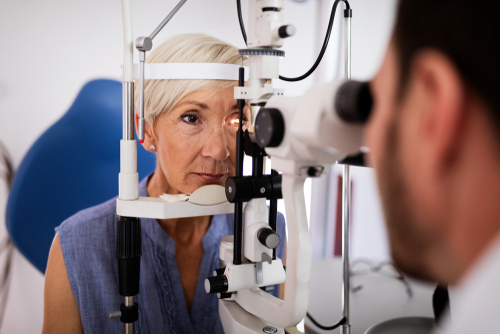
November is Diabetic Eye Disease Awareness Month, making it the perfect time to learn about the signs of diabetic retinopathy and other vision problems caused by diabetes. Diabetic eye disease is a leading cause of blindness, but early detection and treatment can prevent severe vision loss.
Keep reading to learn five key indicators that your diabetes may be affecting your eyes!
1. Blurred Vision
One of the first symptoms is blurred vision that comes and goes. This blurring may be minor at first but can progress over time.
Blurred vision makes it difficult to read, drive, or see details clearly. You may notice problems focusing on close objects one day and distance vision the next.
Blurring tends to recur and become more persistent as the disease advances.
2. Floaters and Spots
You may start to notice small specks or strings that seem to float through your field of vision. These floaters and spots are caused by leaking or bleeding of abnormal blood vessels in the retina at the back of the eye.
While often harmless, it’s important to monitor any new onset of floaters, which look like small circles, threads, or cobwebs drifting before your eyes. If you experience a sudden appearance of numerous floaters, it’s best to see your eye doctor right away.
3. Impaired Color Vision
Colors may appear washed out, faded, or blurry. This abnormal color perception results from changes to the retina and can be one of the earliest signs of diabetic eye disease.
Impaired color vision can make it hard to distinguish between colors and shades. Reds may seem muted, greens appear grayish, and hues look less vivid overall.
This change in color vision tends to develop gradually and worsen over time.
4. Vision Loss
Over time, diabetic retinopathy can permanently damage blood vessels in the retina, leading to patches of vision loss. This serious symptom typically only occurs in advanced stages of untreated diabetic eye disease.
Peripheral vision is usually affected first, causing missing areas in your side vision. Without treatment, the blind spots can also spread to affect your central vision. Vision loss is permanent once it occurs.
5. Fluctuating Vision
Your vision clarity may fluctuate daily as your blood sugar levels rise and fall. For example, you may see well in the morning, but your sight worsens later in the day.
This instability requires rapid medical care to prevent long-term issues. Ongoing ups and downs with vision changes indicate your diabetes is poorly controlled.
Keeping blood sugars steady can help stabilize visual symptoms.
When To Seek Treatment
If you experience any of the above symptoms, it’s essential to schedule an appointment with your eye doctor right away. However, remember to seek emergency care if you suddenly lose vision in one eye.
By recognizing these common symptoms early, you can seek emergency eye exams and prevent severe vision loss from diabetes. With prompt treatment, it may be possible to slow or stop the progression of diabetic retinopathy.
Regular eye exams are crucial for catching diabetic eye disease in the early stages. All people with diabetes should have a dilated eye exam at least once a year.
More frequent exams may be needed if you are experiencing vision changes. Early detection gives you the best chance of protecting your sight.
Are you experiencing changes in your vision? Schedule an appointment at Eyecare Medical Group in Portland, ME, today!





